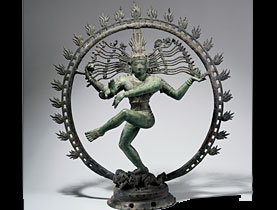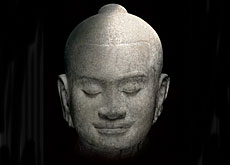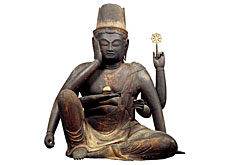Shiva’s dance of life and death

Shiva is among the most important Hindu gods. At once terrible and benevolent, he is never more powerful than when he is dancing.
His appeal has spread beyond the borders of his homeland of India. An exhibition at the Rietberg Museum in Zurich is exploring why so many people are drawn to the Dancing Shiva.
The image of Shiva as the Lord of the Dance – multi-armed, posed on one leg, surrounded by a circle of fire, his hair flying – is one of the god’s most famous incarnations.
The Rietberg Museum in Zurich, which is devoted to non-European art and artefacts, boasts its own impressive bronze Dancing Shiva, dating from the 11th century. It was bought by the museum’s founder and collector Eduard von der Heydt in the 1920s-1930s.
The statue has been the inspiration for the “Shiva Nataraja: The Cosmic Dancer” exhibition, which opened on November 16.
“This bronze is a landmark of our museum, it is among the most beautiful pieces we own and is definitely the ultimate object in the Indian collection,” the exhibition’s curator, Johannes Beltz, told swissinfo.
“But never before has an exhibition at the Rietberg been dedicated to Shiva as a Cosmic Dancer exclusively,” he said.
God of contradictions
Shiva is a god of contradictions: a family man, a hermit, a warlike king, a teacher… and when he is dancing, he embodies both creation and destruction.
“He is the one who makes the world – and who destroys it in the end to open doors for new creation,” explained Beltz, an expert in Indian art.
“He is a metaphor for the cycles of life, for change, for transformation. He is the one who transforms the darkness into light and dirt into gold.”
Set out as a temple, the exhibition shows Shiva in all his incarnations. We meet wife Parvati – the only one who can calm him – and his divine children.
We learn about his saints, each with their own heart-rending story of devotion to their god. This includes Karaikkalammaiyar, represented in a bronze as a skeletal woman who has renounced her good looks and health for Shiva.
There are 33 bronzes and five huge stone sculptures on display, many having come from some of the most renowned institutions in the world, such as the British Museum in London.
Rare Indian loans
A particular coup, however, has been the loan of objects from two museums in India.
R. Balasubramanian, a curator from the Government Museum Chennai in Southern India, the traditional heartland of Shiva, travelled to Switzerland with four precious items.
For him, the display certainly does justice to its divine subject.
“The exhibition is a grand success,” he told swissinfo. “I feel they have made an excellent work in doing the exhibition. It is very splendorous.”
In all, the show took five years to organise, including fieldwork in India.
Beltz said his aim was to highlight the beauty and charm of the Cosmic Dancer and his entourage. But he also wanted to explore the more mysterious aspects of the god.
At present very little is known about the origins of this icon of Hinduism – which is the world’s third-largest religion. However, the god is still very much celebrated today.
Shiva’s appeal
The Dancing Shiva made a particular impression in Switzerland and western Europe in the early 20th century, around the time that von der Heydt purchased the Rietberg bronze. Photographs at the exhibition show, for example, the Dutch spy Mata Hari doing an Indian dance.
Beltz says that the aesthetics of the Nataraja in part explains its appeal. “When you see the form, it resembles a Leonardo da Vinci composition. You have the human body in a circle, you have the god dancing,” he explained.
And of course, the fact that the god can be wild and dangerous, and yet benevolent and beautiful – as witnessed in many of the items on display – is also an important aspect.
“Shiva is the one who transforms the universe – he is beyond the circle of birth and death, of creation and destruction. This is a very powerful metaphor and a strong image and this is what fascinates people,” Beltz said.
swissinfo, Isobel Leybold-Johnson in Zurich
“Shiva Nataraja – The Cosmic Dancer” runs until March 1, 2009.
It shows 33 bronzes and five monumental stone sculptures from the Chola period (9th-12th centuries) as well as select examples of 18th-century South Indian painting.
Apart from Shiva, his wife, the goddess Parvati, is also represented, as well as the couple’s divine children, Ganesha and Skanda (Murukan in Tamil). Nandi, the bull which carries Shiva, is also represented. Effigies of the 63 Shaivist saints can also be seen.
A series of parallel events to the display are being held, which include India’s star dancer Malavika Sarukkai, singers from South India and “The Zurich Chamber Orchestra at the Museum Rietberg”, which features several concerts on the subject of creation.

In compliance with the JTI standards
More: SWI swissinfo.ch certified by the Journalism Trust Initiative



You can find an overview of ongoing debates with our journalists here . Please join us!
If you want to start a conversation about a topic raised in this article or want to report factual errors, email us at english@swissinfo.ch.